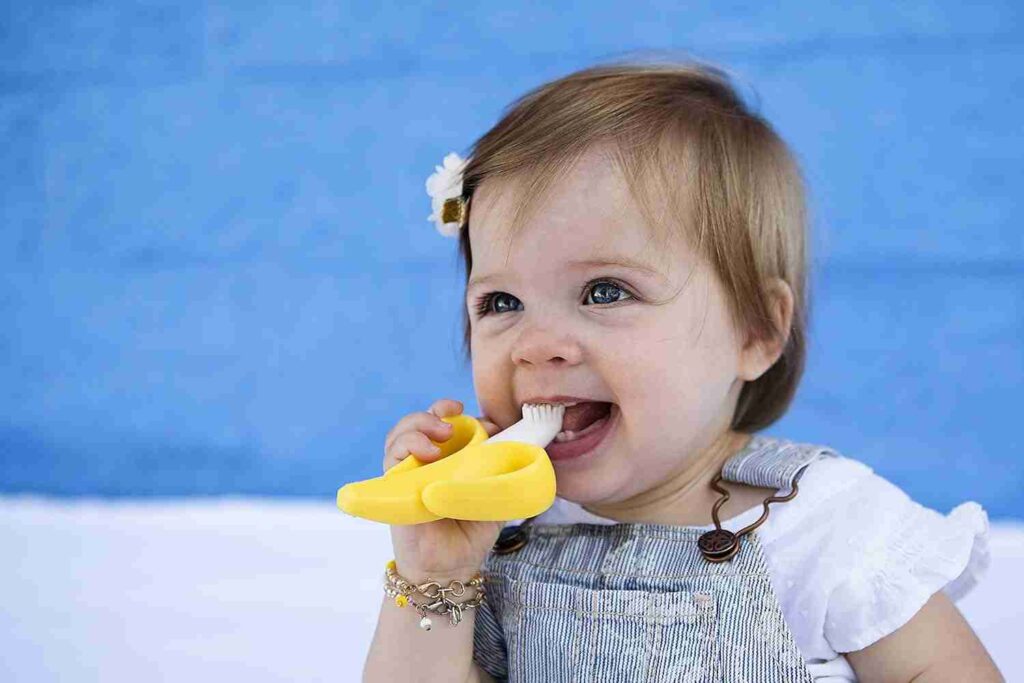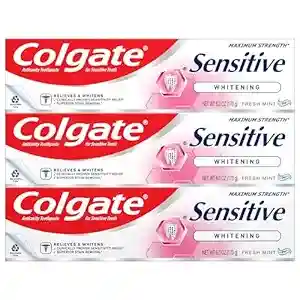Introduction
Establishing good dental hygiene habits early on is essential for your child’s overall health. Choosing the suitable Baby toothbrushes is a crucial step in this process. This guide explores various types of baby toothbrushes, their features, and tips for ensuring your child enjoys brushing their teeth.
1. Understanding the Importance of Oral Care for Babies
Table of Contents
1.1. Why Start Early?
Dental care should begin as soon as the first tooth appears with oral care and brushing baby teeth is crucial for several reasons:
Prevents Oral Health Issues
1. Tooth decay: Early brushing helps prevent bacteria buildup and tooth decay.
2. Gum disease: Regular cleaning prevents gum inflammation and disease.
3. Oral infections: Early care reduces the risk of oral infections.
Develops Good Habits
1. Lifelong oral hygiene habits
2. Encourages healthy dental routines
3. Boosts confidence in dental care
Supports Teething
1. Soothes gum irritation
2. Reduces teething pain
3. Helps new teeth erupt smoothly
Promotes Healthy Development
1. Strong teeth and gums
2. Proper jaw alignment
3. Supports overall health and well-being
Early Intervention
1. Detects oral health issues early
2. Prevents complex problems
3. Reduces future dental costs
American Academy of Pediatric Dentistry (AAPD) Recommendations
1. Clean gums and emerging teeth from birth
2. Introduce toothbrush at 6-12 months
3. Brush twice a day with infant-friendly toothpaste
Benefits of Early Brushing
1. Healthy smile
2. Strong teeth and gums
3. Reduced risk of oral health issues
4. Lifelong oral hygiene habits
5. Boosts confidence
1.2. The Role of Baby Teeth
Baby teeth, also known as primary teeth, are vital in a child’s oral development and overall health. Although they eventually fall out, baby teeth serve several essential purposes. Baby teeth begin erupting around six months old and continue to emerge until the child is about three years old. These teeth help:
Facilitate Chewing and Digestion: Baby teeth enable children to chew and grind food properly, ensuring adequate nutrition for growth and development.
Support Speech Development: Baby teeth aid in forming words and sounds, supporting language skills and communication.
Maintain Jaw Alignment: Primary teeth help guide the growth of the jawbone, ensuring proper alignment and spacing for permanent teeth.
Hold Space for Permanent Teeth: Baby teeth reserve space for the eruption of permanent teeth, preventing overcrowding and orthodontic issues.
Boost Confidence and Self-Esteem: A healthy, complete set of baby teeth contributes to a beautiful smile, enhancing self-confidence and self-esteem.
Additionally, baby teeth are crucial for:
Developing Oral Hygiene Habits: Caring for baby teeth introduces children to essential oral hygiene practices, setting the stage for lifelong dental care.
Preventing Oral Health Issues: Healthy baby teeth reduce the risk of tooth decay, gum disease, and other oral health problems.
1.3. Establishing Healthy Habits
Teaching children about dental hygiene early helps them develop lifelong habits that promote oral health. Establishing healthy habits in children from a young age sets the foundation for a lifetime of well-being. Developing good habits early on can have a profound impact on their physical, emotional, and mental health.
Oral hygiene habits
Teaching children to brush and floss regularly from infancy helps create a lifelong routine. This prevents tooth decay and gum disease and promotes healthy smiles.
Healthy Eating Habits
Encouraging balanced diets rich in fruits, vegetables, and whole foods helps children develop taste preferences for nutritious options. Limiting sugary and processed foods reduces the risk of obesity, diabetes, and other health issues.
Physical Activity Habits
Engaging children in regular exercise, such as outdoor play or sports, fosters a love for physical activity. This promotes strong bones and cardiovascular health and reduces sedentary behavior.
Sleep Habits
Establishing consistent bedtime routines and ensuring adequate sleep (8-12 hours for children) supports cognitive development, emotional regulation, and physical growth.
Emotional Well-being Habits
Modeling and teaching healthy emotional expression, empathy, and self-awareness helps children develop resilience and coping skills.
Benefits of Healthy Habits
1. Boosts self-confidence and self-esteem
2. Enhances cognitive development and academic performance
3. Supports physical and mental health
4. Fosters healthy relationships and social skills
5. Encourages responsibility and accountability
Tips for Parents
1. Lead by example
2. Start early and be consistent
3. Make habits fun and engaging
4. Gradually increase responsibility
5. Offer positive reinforcement and praise
By instilling healthy habits in children, parents and caregivers can empower them to thrive and enjoy a lifetime of wellness.
2. Types of Baby Toothbrushes
2.1. Finger Toothbrushes
Finger toothbrushes are silicone brushes that fit over an adult’s finger, making them easy to use.
Pros and Cons
Here’s a detailed list of the pros and cons of finger toothbrushes
Pros
1. Gentle on gums and teeth
2. Easy to use, especially for infants and young children
3. Portable and convenient
4. Affordable
5. Helps with teething pain
6. Introduces oral care habits
7. Promotes healthy habits
8. Suitable for infants (0-3 years)
9. Dentist-recommended
10. Soft bristles, flexible Design
Cons
1. Limited effectiveness for removing plaque and tartar
2. May not be as efficient as traditional toothbrushes
3. Difficulty reaching back teeth
4. Requires frequent replacement (every 1-2 months)
5. May not be suitable for children with sensitive gag reflex
6. Risk of bacterial growth if not cleaned properly
7. Limited durability
8. Not designed for long-term use
9. May not be effective for children with orthodontic appliances
10. Requires proper technique to avoid gum damage
Additional Considerations
1. Material: Silicone or soft-bristled
2. Size: Ensure proper fit for the child’s mouth
3. Hygiene: Clean and store properly
4. Replacement: Regularly replace to maintain effectiveness
5. Supervision: Adult supervision recommended
Who Should Use Finger Toothbrushes
1. Infants (0-12 months)
2. Toddlers (1-3 years)
3. Children with special needs
4. Those with sensitive teeth or gums
5. Travel or on-the-go oral care
Alternatives to Finger Toothbrushes
1. Traditional toothbrushes
2. Electric toothbrushes
3. Interdental brushes
4. Toddler toothbrushes with handles.
Types of Finger Toothbrushes
1. Silicone Finger Toothbrushes
2. Soft-Bristled Finger Toothbrushes
3. Infant Finger Toothbrushes with Handles
4. Disposable Finger Toothbrushes
Popular Brands
1. MAM
2. Tommee Tippee
3. Oral-B
4. Philips Avent
5. Dr. Brown’s
Tips for Using Finger Toothbrushes
1. Wet the brush with water or infant-friendly toothpaste.
2. Gently massage gums and teeth in circular motions.
3. Focus on front and back surfaces.
4. Clean the brush after each use.
5. Replace every 1-2 months or as recommended.
2.2. Manual Baby Toothbrushes
Description
Manual toothbrushes designed for babies typically have soft bristles and small heads.
Pros and Cons
Pros
1. Gentle on gums and teeth
2. Effective plaque removal
3. Easy to maneuver
4. Portable and convenient
5. Affordable
6. Promotes healthy oral habits
7. Suitable for infants and toddlers
8. No batteries required
9. Easy to clean and maintain
10. Variety of designs and colors
Cons
1. Requires manual dexterity
2. May not be as effective as electric toothbrushes
3. Bristles may wear out quickly
4. Requires frequent replacement (every 1-2 months)
5. May not reach all areas of the mouth
6. Can be difficult for young children to use independently
7. May not be suitable for children with special needs
8. Limited durability
9. May not have a built-in timer
10. Requires proper technique to avoid gum damage
Additional Considerations
1. Material: Look for BPA-free and FDA-approved materials
2. Size: Ensure proper fit for the child’s mouth
3. Hygiene: Clean and store properly
4. Replacement: Regularly replace to maintain effectiveness
5. Supervision: Adult supervision recommended
Who Should Use Manual Baby Toothbrushes
1. Infants (0-12 months)
2. Toddlers (1-3 years)
3. Children with sensitive teeth or gums
4. Those who prefer manual toothbrushes
5. Travel or on-the-go oral care
Alternatives
1. Electric baby toothbrushes
2. Finger toothbrushes
3. Interdental brushes
4. Toddler toothbrushes with handles
Popular Brands
1. Oral-B Stages
2. MAM Baby’s First Toothbrush
3. Tommee Tippee Closer to Nature
4. Philips Avent Infant Toothbrush
5. Dr. Brown’s Infant Toothbrush

Tips for Choosing
1. Consult your pediatrician or dentis
2. Consider your child’s comfort and preference
3. Look for certifications (e.g., ADA, ISO)
4. Check the material and construction
5. Replace every 1-2 months
How to Use
1. Wet the toothbrush with water or infant-friendly toothpaste
2. Gently brush the front and back surfaces
3. Focus on gum lines
4. Use circular motions
5. Brush twice a day (morning and night)
2.3. Electric Baby Toothbrushes
Electric baby toothbrushes are designed to gently and effectively clean tiny teeth and gums. Here’s what you need to know
Benefits
1. Easier to use for parents and toddlers
2. More efficient plaque removal
3. Gentle on gums and teeth
4. Fun and engaging designs
5. Timed brushing sessions
6. Rechargeable batteries
7. Portable and travel-friendly
8. Suitable for infants and toddlers
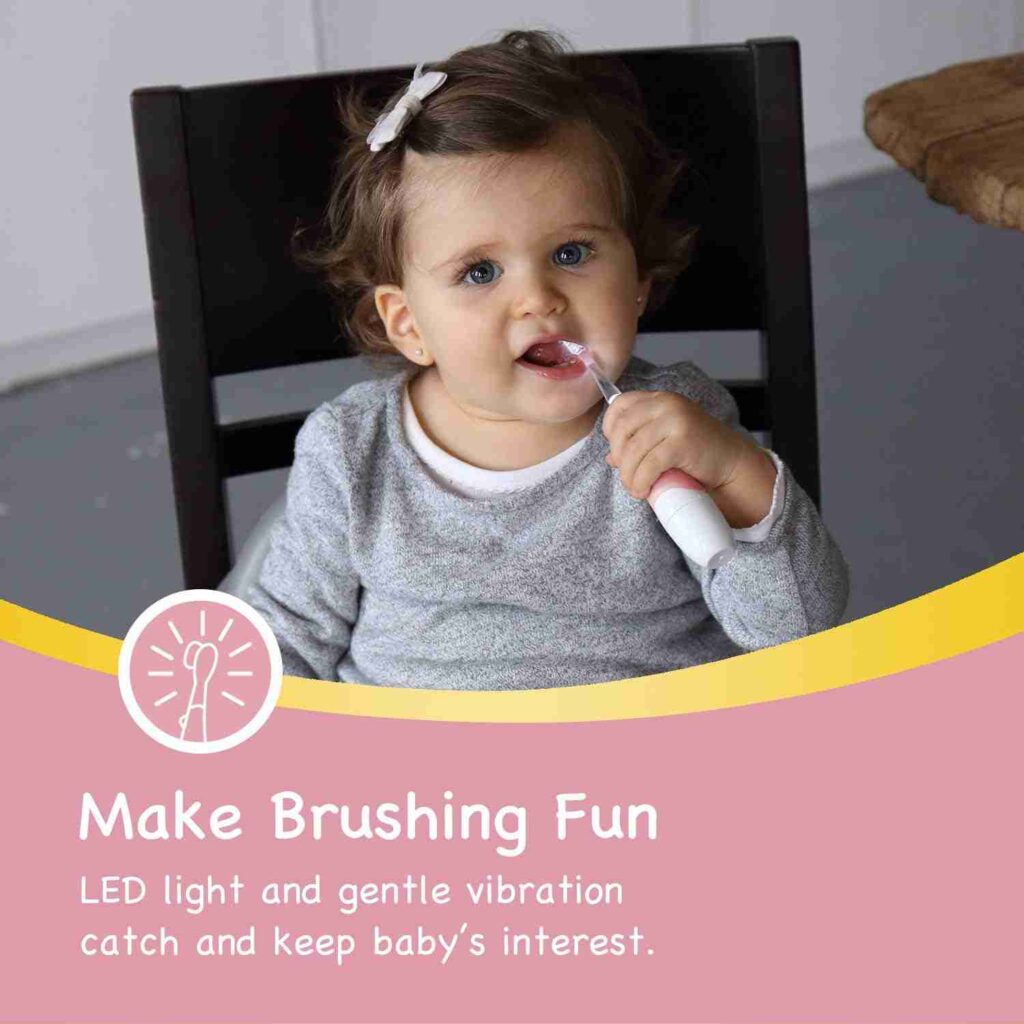
Features to Look for
1. Soft bristles or silicone head
2. Adjustable speed settings
3. Timed brushing sessions (30 seconds to 2 minutes)
4. Rechargeable battery
5. Waterproof Design
6. BPA-free and FDA-approved materials
7. Colorful, child-friendly designs
8. Compact travel case
Popular Brands
1. Oral-B Stages Power
2. Philips Avent Electric Toothbrush
3. Tommee Tippee Electric Toothbrush
4. MAM Electric Baby Toothbrush
5. Spinbrush Baby Electric Toothbrush
Age-Specific Options
1. Infants (0-12 months): Gentle, soft-bristled electric toothbrushes
2. Toddlers (1-3 years): Training electric toothbrushes with larger handles
Tips for Choosing
1. Consult your pediatrician or dentist
2. Consider your child’s comfort and preference
3. Look for certifications (e.g., ADA, ISO)
4. Check the material and construction
5. Replace brush head every 1-2 months
How to Use
1. Wet the toothbrush with water or infant-friendly toothpaste
2. Place toothbrush against teeth and gums
3. Turn on and adjust speed
4. Brush front and back surfaces
5. Focus on gum lines
6. Use timed brushing sessions
Safety Precautions
1. Supervise your child during use
2. Ensure proper assembly and maintenance
3. Avoid submerging in water
4. Keep out of reach of other children
Pros and Cons
Pros
– Easier to use
– More efficient cleaning
– Fun designs
– Timed brushing sessions
Cons
– Requires batteries
– More expensive than manual toothbrushes
– May be too loud for some children
– Limited durability
.4. Training Toothbrushes
Description: Training toothbrushes are designed to help children transition from infant to adult-sized toothbrushes. Here’s what you need to know.
Types of Training Toothbrushes
1. Toddler training toothbrushes (ages 1-3)
2. Preschool training toothbrushes (ages 3-5)
3. Youth training toothbrushes (ages 5-7)
Features
1. Larger handles for easier grip
2. Smaller heads for targeted cleaning
3. Soft bristles or silicone heads
4. Colorful, child-friendly designs
5. Timed brushing sessions
6. Battery-powered or manual options
Benefits
1. Develop a proper brushing technique
2. Encourages independence
3. Builds confidence
4. Prepares children for adult-sized toothbrushes
5. Fun and engaging designs
Popular Brands
1. Oral-B Stages
2. Philips Avent
3. Tommee Tippee
4. MAM
5. Colgate Kids
Tips for Choosing
Training toothbrushes are designed to help children transition from infant to adult-sized toothbrushes. Here’s what you need to know:
How to Use
1. Demonstrate proper brushing technique
2. Supervise and assist as needed
3. Encourage timed brushing sessions
4. Focus on front and back surfaces
5. Gradually increase brushing time
Training Toothbrush Stages
1. Stage 1 (ages 1-2): Soft-bristled, small-headed toothbrushes
2. Stage 2 (ages 2-3): Larger handles, smaller heads
3. Stage 3 (ages 3-5): Adult-sized toothbrushes with training handles
Additional Tips
1. Make brushing fun with songs and games
2. Use child-friendly toothpaste
3. Encourage twice-daily brushing
4. Praise and reward progress
3. Key Features to Look For
3.1. Bristle Softness
Ultra-soft bristles are essential for gentle cleaning without hurting sensitive gums. Bristle softness is crucial for children’s toothbrushes to ensure gentle cleaning and comfort. Here’s what you need to know:
Types of Bristle Softness
1. Extra-Soft (0.1-0.3 mm): Ideal for infants and toddlers
2. Soft (0.3-0.5 mm): Suitable for preschoolers
3. Medium-Soft (0.5-0.7 mm): For school-age children
4. Medium (0.7-1.0 mm): For pre-teens
Bristle Materials
1. Nylon: Soft and flexible
2. Polyester: Gentle and durable
3. Silicone: Soft and hypoallergenic
Benefits of Soft Bristles
1. Gentle on gums and teeth
2. Reduces risk of gum damage
3. Comfortable for sensitive teeth and gums
4. Effective plaque removal
5. Suitable for children with special needs
Factors Affecting Bristle Softness
1. Age: Softer bristles for younger children
2. Gum sensitivity: Softer bristles for sensitive gums
3. Tooth alignment: Softer bristles for crowded or overlapping teeth
4. Oral health: Softer bristles for children with oral health issues
Popular Brands with Soft Bristles
1. Oral-B Stages
2. Philips Avent
3. Tommee Tippee
4. MAM
5. Colgate Kids
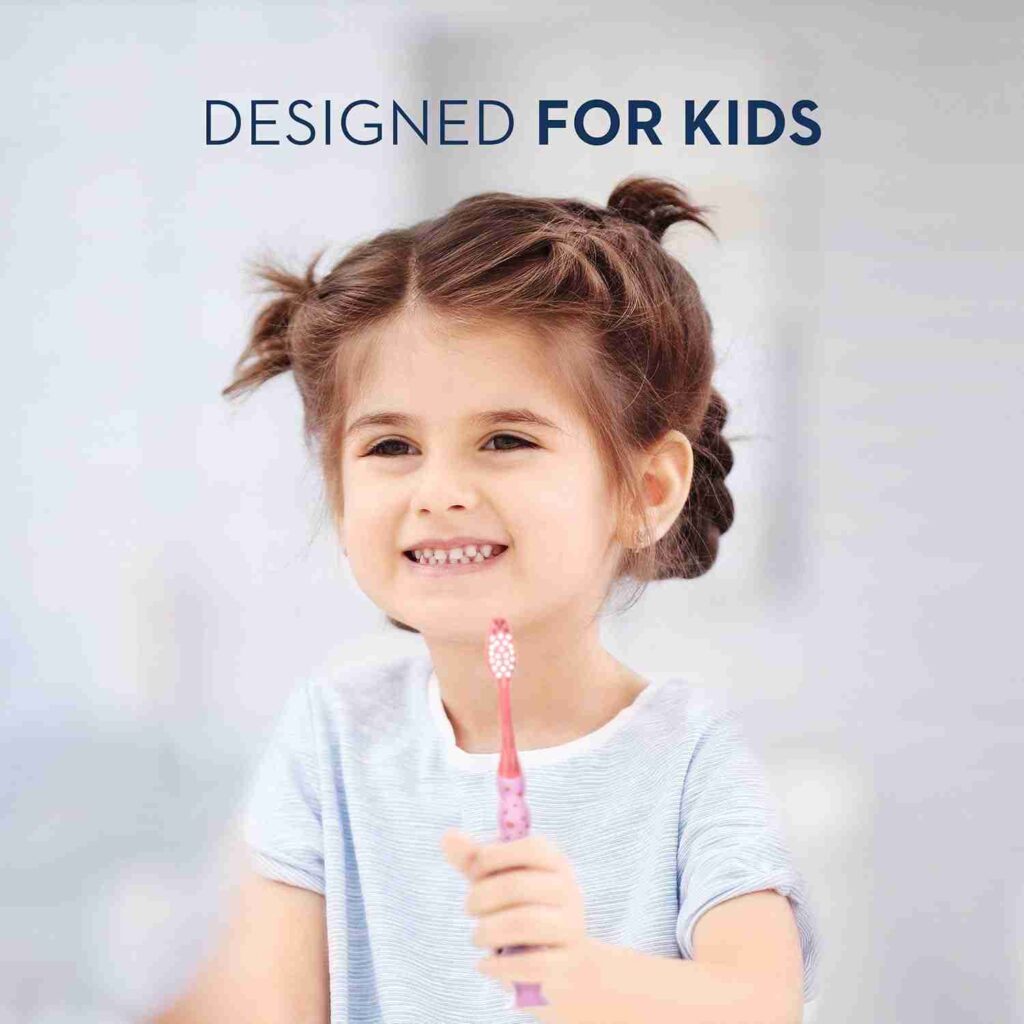
Tips for Choosing
1. Consult your pediatrician or dentist
2. Consider your child’s comfort and preference
3. Look for certifications (e.g., ADA, ISO)
4. Check the material and construction
5. Replace brush head every 1-2 months
Additional Considerations
1. Bristle pattern: Angled or curved bristles for better cleaning
2. Bristle length: Shorter bristles for better maneuverability
3. Handle design: Ergonomic handles for easy grip
3.2. Handle Design
Handle design is crucial for children’s toothbrushes, ensuring comfort, control, and ease of use. Here’s what you need to know:
Types of Handle Designs
1. Contoured handles: Ergonomic Design for comfortable grip
2. Straight handles: Simple, easy-to-manipulate Design
3. Curved handles: For better reach and maneu verability
4. Angled handles: For optimal brushing angle
5. Anti-slip handles: Textured or rubberized for secure grip
Features to Consider
1. Size: Larger handles for toddlers, smaller for older children
2. Material: Soft-grip materials (e.g., rubber, silicone)
3. Shape: Contoured or rounded for comfortable hold
4. Texture: Anti-slip textures or patterns
5. Color: Bright, child-friendly color
Benefits of Ergonomic Handles
1. Easy to hold and maneuver
2. Reduces fatigue and strain
3. Improves brushing technique
4. Encourages independence
5. Suitable for children with special needs
Popular Brands with Ergonomic Handles
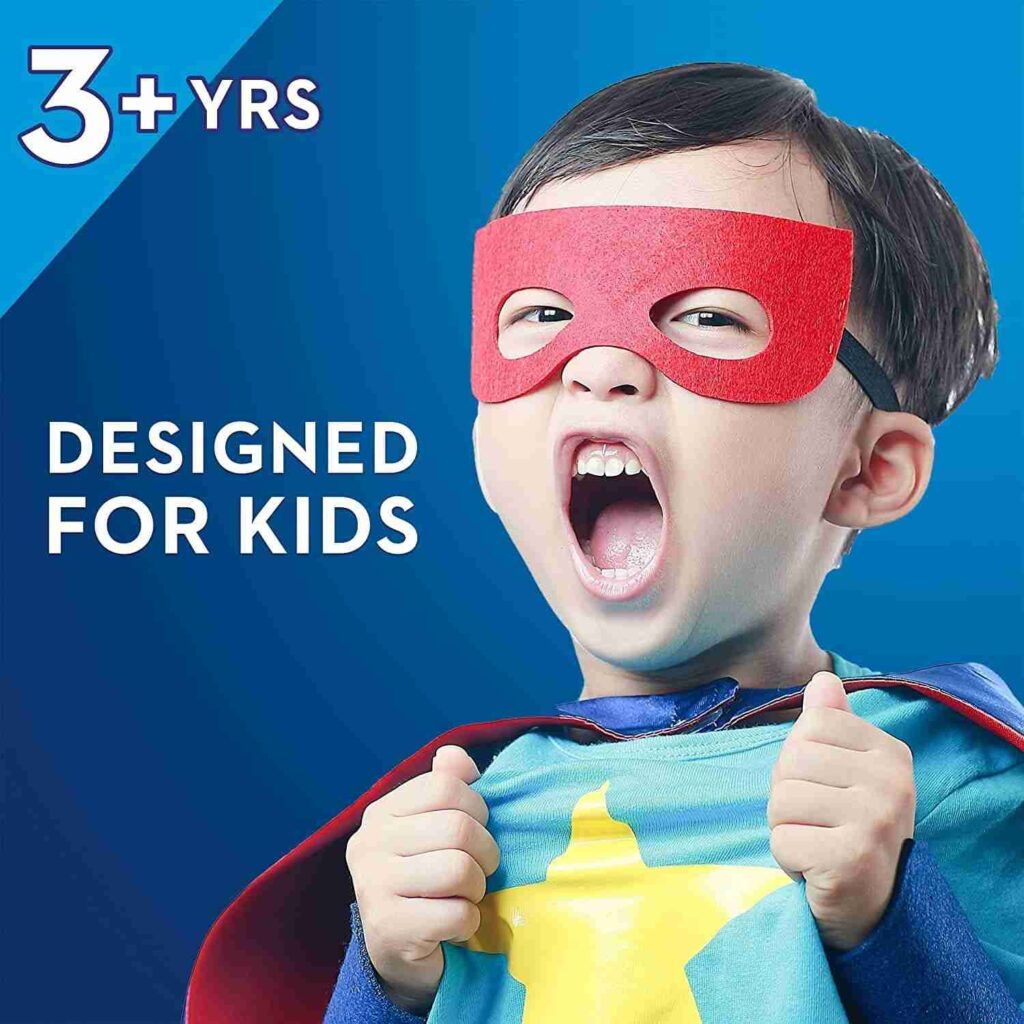
2. Philips Avent
3. Tommee Tippee
4. MAM
5. Colgate Kids
Tips for Choosing
1. Consider your child’s hand size and grip
2. Look for certifications (e.g., ADA, ISO)
3. Check the material and construction
4. Ensure anti-slip features
5. Replace toothbrush every 1-2 months
Additional Considerations
1. Handle length: Longer handles for better reach
2. Handle width: Thicker handles for easier grip
3. Weight: Lightweight for comfortable use
4. Balance: Balanced Design for effortless brushing
3.3. Size of the Brush Head
The size of the brush head is crucial for effective cleaning and comfort. Here’s what you need to know:
Brush Head Sizes:
1. Infant (0-12 months): Small (0.5-1.0 cm)
2. Toddler (1-3 years): Small-Medium (1.0-1.5 cm)
3. Preschooler (3-5 years): Medium (1.5-2.0 cm)
4. School-age (6-12 years): Medium-Large (2.0-2.5 cm)
Features to Consider
1. Compact head: Easy to maneuver in small mouths
2. Narrow head: For better access to back teeth
3. Angled head: For optimal brushing angle
4. Soft-bristled head: Gentle on gums and teeth
Benefits of Proper Brush Head Size
1. Effective plaque removal
2. Comfortable brushing experience
3. Easy to maneuver
4. Reduces gum irritation
5. Suitable for small mouths
Popular Brands with Adjustable Brush Heads
1. Oral-B Stages
2. Philips Avent
3. Tommee Tippee
4. MAM
5. Colgate Kids
Tips for Choosing
1. Consult your pediatrician or dentist
2. Consider your child’s mouth size and comfort
3. Look for certifications (e.g., ADA, ISO)
4. Check the material and construction
5. Replace brush head every 1-2 months
Additional Considerations
1. Brush head shape: Rounded or angled for better cleaning
2. Bristle length: Shorter bristles for better maneuverability
3. Handle size: Larger handles for easier grip
4. Weight: Lightweight for comfortable use
3.4. Material Safety
Material safety is crucial when choosing a toothbrush for your child. Here’s what you need to know:
Safe Materials
1. BPA-free plastics
2. Food-grade silicone
3. Nylon bristles
4. Polyester bristles
5. Stainless steel or titanium handles
Materials to Avoid
1. BPA-containing plastics
2. Phthalates
3. Lead
4. Cadmium
5. Mercury
Certifications to Look For
1. FDA-approved
2. ADA (American Dental Association) Seal of Acceptance
3. ISO (International Organization for Standardization) certification
4. CE marking
5. CPSIA (Consumer Product Safety Improvement Act) compliance
Brands with Safe Materials
1. Oral-B
2. Philips Avent
3. Tommee Tippee
4. MAM
5. Colgate Kids
Tips for Ensuring Material Safety
1. Check product labels and packaging
2. Research manufacturer’s safety standards
3. Consult with a pediatrician or dentist
4. Choose reputable brands
5. Regularly inspect toothbrush for damage or wear
Additional Considerations
1. Allergies and sensitivities
2. Environmental concerns (e.g., eco-friendly materials)
3. Durability and longevity
4. Recycling options
5. Manufacturer’s warranty and customer support
3.5. Fun Aesthetics
Bright colors and engaging designs can make brushing more enjoyable for your child. Here are some fun aesthetic options for kids’ toothbrushes:
Colors
1. Bright primary colors (red, blue, yellow)
2. Pastel colors (pink, baby blue, mint)
3. Neon colors (green, orange, purple)
4. Rainbow-colored handles or bristles
Characters
1. Cartoon characters (e.g., Disney, Pixar)
2. Superheroes (e.g., Batman, Spider-Man)
3. Princesses or fairy tale characters
4. Animals (e.g., pandas, monkeys, dolphins)
Designs
1. Fun patterns (e.g., stripes, polka dots, chevrons)
2. Glow-in-the-dark handles or bristles
3. Sparkly or glittery handles
4. Customizable designs (e.g., name or initials)
Shapes
1. Unconventional shapes (e.g., animals, stars, hearts)
2. Ergonomic designs for comfortable grip
3. Compact travel-sized toothbrushes
4. Interchangeable handle designs
Light and Sound
1. Flashing lights or LED lights
2. Music or sound effects (e.g., timer beeps)
3. Vibration or spinning bristles
4. Interactive features (e.g., games, quizzes)
Themed Toothbrushes
1. Movie or TV show-themed toothbrushes
2. Sports-themed toothbrushes (e.g., soccer, basketball)
3. Holiday-themed toothbrushes (e.g., Christmas, Halloween)
4. Educational-themed toothbrushes (e.g., alphabet, numbers)
Brands with Fun Aesthetics
1. Oral-B Kids
2. Colgate Kids
3. Philips Avent
4. Tommee Tippee
5. MAM
Tips for Making Brushing Fun
1. Let your child choose their toothbrush
2. Create a brushing routine with music or games
3. Use a timer or interactive features
4. Make brushing a team effort (e.g., brush together)
5. Reward good oral hygiene habits
4. Top Baby Toothbrush Recommendations
4.1. Baby Banana Teether Toothbrush
Type: Finger Toothbrush
Features: Soft, flexible, and dual-purpose as a teether.
Why It’s Great: Encourages self-brushing while being safe for teething.
4.2. FridaBaby Baby’s First Toothbrush
Type: Manual Toothbrush
Features: Tiny bristles and an ergonomic handle.
Why It’s Great: Specifically designed for infants, making it easy for parents to use.
4.3. NUK Brush and Stage 1 Toothpaste Set
Type: Manual Toothbrush
Features: Soft bristles and an included toothpaste.
Why It’s Great: Provides a complete starter kit for new parents.
4.4. Oral-B Kids Electric Toothbrush
Type: Electric toothbrush
Features: Soft rotating head and built-in timer.
Why It’s Great: It makes brushing fun with characters and songs.
4.5. MAM Training Toothbrush
Type: Manual Toothbrush
Features: Extra-soft bristles and a large handle for little hands.
Why It’s Great: Perfect for toddlers learning to brush independently.
5. Tips for Establishing a Brushing Routine
5.1. Make It Fun
Here are some ideas to make brushing teeth fun for kids:
Games and Challenges
1. Brushing chart: Create a chart to track progress.
2. Timer challenge: Brush for 2 minutes without stopping.
3. Brushing bingo: Mark off each day on a bingo card.
4. Toothbrush racing: Race toothbrushes around the sink.
Music and Videos
1. Brushing songs: Play fun songs during brushing.
2. Video tutorials: Watch kid-friendly oral care videos.
3. Dance party: Brush teeth while dancing.
Storytelling and Characters
1. Create a brushing story: Make up a story while brushing.
2. Toothbrush friends: Give toothbrushes names and personalities.
3. Brushing adventures: Imagine adventures while brushing.
Rewards and Incentives
1. Sticker chart: Reward stickers for each brushing session.
2. Special treats: Offer small treats after brushing.
3. Brushing milestones: Celebrate milestones (e.g., 30 days).
Interactive Features
1. Spin brushes: Use spinning toothbrushes.
2. Glow-in-the-dark toothbrushes
3. Brushing apps: Download interactive oral care apps.
Make it a Routine
1. Brush together: Make brushing a family activity.
2. Routine chart: Create a daily routine chart.
3. Brushing buddies: Assign brushing buddies.
Educational
1. Learn about teeth: Teach kids about oral health.
2. Tooth anatomy: Explore tooth structure.
3. Healthy habits: Discuss the importance of brushing.
Creative Freedom
1. Choose a toothbrush: Let kids pick their toothbrush.
2. Toothpaste flavors: Offer a variety of flavors.
3. Brushing style: Encourage kids to find their brushing style.
Offer more fun ideas
Here are some ideas to make brushing teeth fun for kids:
Games and Challenges
1. Brushing chart: Create a chart to track progress.
2. Timer challenge: Brush for 2 minutes without stopping.
3. Brushing bingo: Mark off each day on a bingo card.
4. Toothbrush racing: Race toothbrushes around the sink.
Music and Videos
1. Brushing songs: Play fun songs during brushing.
2. Video tutorials: Watch kid-friendly oral care videos.
3. Dance party: Brush teeth while dancing.
Storytelling and Characters
1. Create a brushing story: Make up a story while brushing.
2. Toothbrush friends: Give toothbrushes names and personalities.
3. Brushing adventures: Imagine adventures while brushing.
Rewards and Incentives
1. Sticker chart: Reward stickers for each brushing session.
2. Special treats: Offer small treats after brushing.
3. Brushing milestones: Celebrate milestones (e.g., 30 days).
Interactive Features
1. Spin brushes: Use spinning toothbrushes.
2. Glow-in-the-dark toothbrushes
3. Brushing apps: Download interactive oral care apps.
Make it a Routine
1. Brush together: Make brushing a family activity.
2. Routine chart: Create a daily routine chart.
3. Brushing buddies: Assign brushing buddies.
Educational
1. Learn about teeth: Teach kids about oral health.
2. Tooth anatomy: Explore tooth structure.
3. Healthy habits: Discuss the importance of brushing.
Creative Freedom
1. Choose a toothbrush: Let kids pick their toothbrush.
2. Toothpaste flavors: Offer a variety of flavors.
3. Brushing style: Encourage kids to
5.2. Brush Together
Demonstrate proper brushing technique by brushing your teeth alongside your child. Brushing together is a beautiful way to make oral care a fun, family-bonding experience! It encourages consistency, models good habits, and fosters teamwork. Choose a consistent time and place, use a timer or song, and make it a ritual. Discuss oral health, praise each other’s efforts, and enjoy quality time together. For kids, brushing together helps develop lifelong habits and builds confidence. For parents, it’s a chance to lead by example and create lasting memories.
5.3. Use a Timer
Setting a two-minute timer encourages children to brush for the recommended duration. Using a timer makes brushing your teeth a fun and efficient experience for kids! It ensures an entire 2-minute brushing session, encourages consistency, and helps kids focus. Choose from traditional sand timers, digital timers on toothbrushes, or smartphone apps like Brush DJ or Toothsaurus. Set the timer twice daily and make it a part of your child’s daily routine. You can even create a brushing playlist or reward timer milestones to make the experience more engaging!
5.4.Praise and Encourage
Praise and encouragement go a long way in developing good oral hygiene habits in kids! Acknowledge and celebrate their efforts, no matter how small. Use positive affirmations like “Great job brushing your teeth!” or “You’re doing a fantastic job taking care of your smile!” Be specific with praise, highlighting their progress and improvements. Encourage independence by letting them choose their toothbrush or toothpaste. This boosts confidence, motivates them to continue good habits, and creates a lifelong commitment to oral health.
5.5. Consistency is Key
Establish a daily routine for brushing at the exact times each day. Consistency is the key to developing good oral hygiene habits in kids. Establish a daily routine, brushing teeth at the precise times (morning and night) and for the same duration (2 minutes). Stick to it, even on weekends and vacations. Consistency helps create a habit, making brushing teeth an automatic part of daily life. Encourage kids to take ownership by letting them choose their toothbrush or toothpaste. Reward consistency with stickers or stars on a chart, fostering a sense of accomplishment and responsibility.
6. Transitioning to a Toddler Toothbrush
Transitioning to a toddler brush typically occurs around 18-24 months, when children develop sufficient motor skills to hold and maneuver a toothbrush.
Signs Ready for Toddler Brush
1. Shows interest in brushing teeth
2. Can hold the toothbrush and move it around the mouth
3. Has sufficient hand-eye coordination
4. Can spit out toothpaste (with guidance)
Tips for Transition
1. Gradual introduction: Start with soft-bristled infant toothbrush
2. Choose a toddler-friendly Design: Large handle, small head
3. Demonstrate proper technique
4. Practice together, then independently
5. Supervise and provide guidance
6. Make brushing fun: Use songs, stories, and characters
Recommended Toddler Toothbrush Features
1. Soft bristles
2. Small brush head
3. Easy-grip handle
4. Non-slip Design
5. Colorful and engaging Design
Popular Toddler Toothbrush Brands
1. Oral-B Stages
2. Colgate Kids
3. Tommee Tippee
4. MAM
5. Philips Avent
Additional Tips
1. Use training toothpaste (low fluoride)
2. Brush twice a day (morning and night)
3. Encourage independence, but supervise
4. Replace toothbrush every 3-4 months
7. Common Mistakes to Avoid
7.1. Using Adult Toothpaste
Always use toothpaste made for babies or toddlers, which is fluoride-free.
7.2. Neglecting to Replace Toothbrushes
Toothbrushes should be replaced every three to four months or sooner if bristles become frayed.
7.3. Ignoring Gums
Cleaning gums is essential even after teeth appear, promoting overall gum health.
8. Frequently Asked Questions
8.1. How often should I brush my baby’s teeth?
Brush twice a day, especially after meals and before bedtime.
8.2. When should I introduce toothpaste?
Introduce a tiny smear of fluoride-free toothpaste when the first tooth appears.
8.3. How can I encourage my baby to enjoy brushing?
Make it a fun activity with songs or by brushing together.
Conclusion
Choosing the right toothbrush for your baby is vital for instilling good oral hygiene habits. With various options available, selecting a toothbrush that meets your child’s needs will promote a positive brushing experience. Starting early and maintaining a routine will help ensure a lifetime of healthy smiles.
Key Takeaways
1. Make brushing your teeth a positive experience.
2. Use timers and games to make brushing fun.
3. Praise and encourage good oral hygiene habits.
4. Establish a consistent daily routine.
5. Transition to a toddler brush around 18-24 months.
By following these tips, you’ll:
1. Encourage healthy teeth and gums.
2. Develop good oral hygiene habits.
3. Boost confidence and independence.
4. Create a lifelong commitment to oral health.

